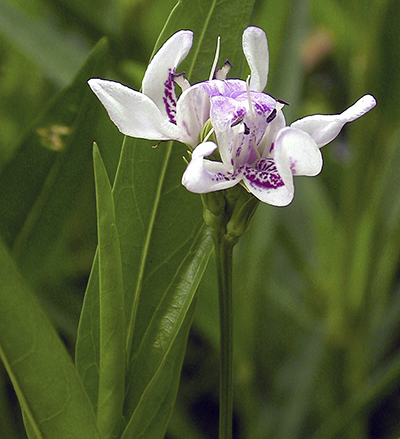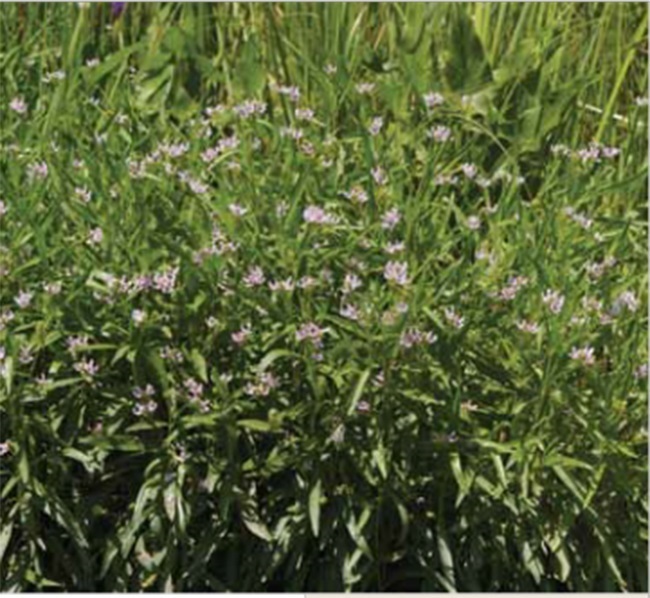American Water-willow

Photo: Sam Brinker
Species information
This chapter provides a review of progress towards the protection and recovery of American Water-willow in Ontario from 2007 to 2017.
American Water-willow (Justicia americana) is an aquatic herbaceous perennial that grows in colonies on the shores of rivers, streams and lakes on substrate of gravel, sand, or organic material. Stems of the American Water-willow, which grow to heights of 20 centimetres to 1 metre, may be simple or branched and rise from a large rhizome that creeps along the ground. The undivided leaves are narrow and elongated in shape, occurring in opposite pairs along the stem, and the tube-shaped white or pale violet flowers grow on long thin stalks. The fruit of the American Water-willow is a capsule containing two to four beige or light brown seeds. American Water-willow is limited to open habitats with little or no competition from other species, and can survive exposure to high wave action as well as being above ground-water level likely because of a strong underground rooted structure.
The populations of American Water-willow in Ontario are geographically isolated from each other and from the main distribution of the species in the southern and eastern United States. American Water-willow has been documented in three areas of Ontario: in Essex County, in the Niagara region, and in the Thousand Islands region. The species was previously reported to have 17 historic occurrences and has since been revised to 15 historical occurrences (revised to 15 in 2018 following NatureServe protocol; see Section 8) and 7 extant occurrences in Ontario, and 11 historic occurrences and 3 extant occurrences in Quebec, one of which accounts for approximately 99 percent of all known stems in Canada.
American Water-willow faces several threats to its survival and recovery including changes in water levels from natural and anthropogenic causes that lead to flooding or drought, loss of habitat from erosion, infilling and dredging, competition from invasive plants (for example, European Common Reed (Phragmites australis subsp. australis)) which outcompete and displace many native species, and trampling from recreational activities.
The survival and recovery of American Water-willow may be influenced by other factors as well. The effects of pollution, in particular the acidification of lakes, on American Water-willow is unknown. Herbivory by deer and other grazing animals has been observed at two colonies of American Water-willow, and although in one case stems were able to sprout again, there was a decline in the colonies’ reproductive success which may be related to grazing.
American Water-willow is listed as threatened at both the provincial level (Species at Risk in Ontario (SARO) List) and federal level (Schedule 1 under the Species at Risk Act). Globally, it is considered to be secure (NatureServe Explorer).
Provincial status
Prior to the Endangered Species Act, 2007 (ESA or the Act
) the Committee on the Status of Species at Risk in Ontario (COSSARO) assessed American Water-willow as threatened. It was listed on the SARO List as threatened in 2004, but was not regulated under the previous Endangered Species Act. The species retained its threatened status when the ESA came into force in 2008. In future assessments, COSSARO may consider information gained through protection and recovery actions regarding the species’ threats and trends in population and distribution.
Species and habitat protection
Protecting American Water-willow and its habitat are key components in the implementation of the ESA and continue to be government-led actions, as identified in the government response statement (GRS). As a threatened species, American Water-willow has been protected from being killed, harmed, harassed, captured or taken under the ESA since it came into force in 2008. The species’ habitat has been protected from being damaged or destroyed since June 30, 2013, based on the general habitat definition in the ESA. The ESA does not require a habitat regulation to be developed for transition
Any person who negatively impacts American Water-willow or its habitat without prior authorization may be prosecuted under the ESA.
American Water-willow has been protected from being killed, harmed, harrassed, captured or taken since 2008.
In addition, the habitat of American Water-willow has been protected from being damaged or destroyed since 2013.
Recovery strategy
A recovery strategy for American Water-willow was published on January 11, 2013, which was in advance of the date required by the ESA. Recovery strategies are advice to government and represent the best available scientific knowledge. The strategy identifies the habitat needs of the species and the threats that it faces, while recommending objectives and approaches for its protection and recovery. The recovery strategy also includes recommendations on the areas of habitat to be considered in the development of a habitat regulation.
Government response statement
The government published the GRS for American Water-willow on October 11, 2013 which was within the timeframe required by the ESA. The GRS is the Government of Ontario’s species-specific policy on what is needed to protect and recover a given species, and includes the associated recovery goal.
To help achieve this goal, the government leads, supports and prioritizes recovery actions identified in the GRS. Common actions for the government to lead as it works towards achieving a species’ recovery goal are provided in section 2.5 of the Species at Risk Program Status (2008-2015). An action in the GRS for the government to lead that is specific to this species, and not included in the typical actions in section 2.5 is:
Recovery Goal
The government’s goal for the recovery of American Water-willow is to maintain the current population levels at existing locations and, if possible, enable increases.
- Conduct surveys for American Water-willow at historical locations in provincial parks and if found protect and maintain suitable habitat.
The GRS for American Water-willow also lists seven actions the Government of Ontario supports others to undertake for the species. These government-supported actions fall under the objectives identified in the GRS, which are:
- Enhance knowledge of American Water-willow distribution and abundance in Ontario
- Determine the natural range of variability in American Water-willow populations and preferred habitat conditions
- Engage local stakeholders in habitat stewardship to benefit American Water-willow
Ontario’s Invasive Species Act
The GRS for American Water-willow indicates that invasive species (e.g. European Common Reed) pose a threat to the survival and recovery of the species in Ontario. The Ontario Invasive Species Strategic Plan, 2012 and the Invasive Species Act, 2015 provide the policy and legislative framework to support the prevention, detection and control of invasive species in Ontario. This framework may support actions to reduce the threats of invasive species.
Government-funded projects
An important government-led action in the GRS for American Water-willow is to support partners to undertake activities to protect and recover the species. Through the Species at Risk Stewardship Program the government has supported two projects designed to contribute to the protection and recovery of American Water-willow.
Stewardship partners reported that provincial funding helped them to secure in-kind support by involving 27 individuals who volunteered 371 hours of their time towards protection and recovery activities that focused exclusively on American Water-willow, which has an estimated value of $14,560. In addition, stewardship partners reported providing focused outreach on American Water-willow to 260 individuals.
The remainder of this section highlights one project supported through the Species at Risk Stewardship Program as well as the corresponding government-supported recovery actions for the species.
In 2014, Land Care Niagara received funding from the Species at Risk Stewardship Program to implement a three-year project entitled Conservation and recovery of the American Water-willow through Stewardship Initiatives
. Focused in the Niagara region, this project’s goal was to increase knowledge of the species’ ecology and habitat requirements by using standardized surveys to monitor known, historic and new populations, determine threats to each population, and collaborate with stakeholders and land owners to reduce threats using various mitigation strategies.
Five survey sites were surveyed for three years of the project: one historic site, three presently occupied sites, and one site being monitored for a future translocation study. Population size and distribution of the species, as well as microclimatic factors and presence of invasive species were recorded throughout the growing season. Water parameters were also collected bi-weekly from May to October, and compared within and between years. New colonies of American Water-willow were discovered in 2016 thanks to expanded search efforts on Lyons Creek, and a historic site on the Welland River was found to have an extant population of over 1,000 stems. New shoreline housing developments and water level fluctuations were identified as the biggest risks to the extant populations.
In addition to surveys, Land Care Niagara collected seed pods for Brock University to help inform their research on propagation feasibility, developed an educational sign for landowners to spread awareness of the species, conducted post-construction impact assessments and monitoring of populations, and worked with a private consultant to conduct an inventory of aquatic vegetation that grows in proximity to American Water-willow. Land Care Niagara worked with numerous stakeholders in the community, hosted an educational event, and conducted a door-to-door campaign to promote awareness of the American Water-willow.
This project supports the GRS actions to enhance knowledge of distribution and abundance of American Water-willow in Ontario, determine the natural range of variability in American Water-willow populations and preferred habitat conditions, and engage with local stakeholders in habitat stewardship to benefit American water-willow.
Species at Risk Stewardship Fund
-
 2
2projects included American Water-willow
-
 $100,310
$100,310for American Water-willow exclusively
-
 $95,155
$95,155in additional funding and in-kind support
-
 27
27volunteers
-
 371
371volunteer hours
-
 260
260people received outreach
Efforts to minimize adverse effects on American Water-willow
Supporting partners through permits and their associated conditions is an important government-led action.
Two permits have been issued for American Water-willow since the species has been protected under the ESA, both of which were ‘protection or recovery’ permits (i.e., 17(2)(b)). ‘Protection or recovery’ permits are issued if the purpose of the activity is to assist in the protection or recovery of a species at risk. Both permits were issued exclusively for American Water-willow. These permits enabled two organizations to undertake collection of plant materials for conducting molecular studies including extracting DNA to examine the viability of the population.
Three activities that may affect American Water-willow or its habitat have been registered for the purposes of the Ontario Regulation 242/08 under the ESA. This includes two activities registered under ‘Species protection or recovery activities’ (section 23.17) and one activity registered under ‘Threats to health and safety, not imminent’ (section 23.18) of Ontario Regulation 242/08. The registrations require the registered individual to comply with all conditions of the regulations, such as:
- Prepare a mitigation plan using best available information on steps that may help minimize or avoid adverse effects on the species and
- Reporting observations of the species using the Ontario Species at Risk Observation Reporting Form and submitting it to the Natural Heritage Information Centre (NHIC).
-
2protection or recovery permits
-
3registrations
Occurrences of American Water-willow in Ontario
Fifteen populations
Since 2008, the government’s central repository at the NHIC has received 194 records of the species. These records are based on observations between 1900 and 2012 and come from a variety of sources. Records submitted have helped to refine where the species is known and has been known to occur and can provide additional information on the species’ habitat and threats.
Since 2008 when the species was listed on the ESA, 4 new populations have been identified and 105 observations have been reported. The newly identified local populations are likely the result of increased search effort and education about American Water-willow and may not represent actual population increases, but rather increased knowledge about the distribution and abundance of the species.
It is possible that there are observations of American Water-willow that have not been submitted to the government. Encouraging the submission of observations of this species to the government is included in the GRS as a government-led action. Submission of species observations to the government increases our knowledge of where they occur and can play an important role in assessing the viability of species populations.
Everyone is encouraged, or may be required by an authorization or approval, to submit observations of American Water-willow, and any other species at risk observed, to the NHIC for incorporation into the provincial record of observations.
194 observations of this species were submitted to the NHIC since 2008
Summary of progress towards meeting the recovery goal
Summary of progress
Progress has been made towards the majority of the government-led actions and the majority of the government-supported actions outlined in the GRS for American Water-willow. The Government of Ontario has directly undertaken actions to:
- Educate other agencies and authorities involved in planning and environmental assessment processes on the protection requirements under the ESA
- Encourage the submission of American Water-willow data to the government’s central repository at the NHIC
- Undertake communications and outreach to increase public awareness of species at risk in Ontario
- Protect American Water-willow and its habitat through the ESA
- Support conservation, agency, municipal, industry partners and Indigenous communities to undertake activities to protect and recover the American Water-willow. Support will be provided through funding, agreements, permits (including conditions) and advisory services
- Establish and communicate annual priority actions for government support in order to encourage collaboration and reduce duplication of efforts
Government-supported actions are organized under recovery objective focus areas. Progress has been made towards all of the government-supported recovery objectives and the majority of the associated actions identified in the GRS for American Water-willow.
Under the objective to enhance knowledge of American Water-willow distribution and abundance in Ontario, progress has been made towards all of the actions.
- Monitor population abundance, demographics, habitat conditions and threats at existing sites (Action No. 1 – High Priority).
- Conduct standardized surveys of suitable habitat and historic sites to try to detect new populations within the species’ current range (Action No. 2).
These actions have been implemented through projects supported by the Species at Risk Stewardship Program to conduct monitoring surveys of historic, existing and new populations within the species’ range. These surveys, authorized by protection or recovery permits issued under the ESA, have resulted in more information about where they occur and how best to protect their habitat in certain areas where they occur.
Under the objective to determine the natural range of variability in American Water-willow populations and preferred habitat conditions, progress has been made towards Action No. 3 and initial progress has been made towards Action No. 4 and Action No. 5.
- Characterize American Water-willow habitat and micro-habitat conditions, including the conditions required for the maintenance and growth of American Water-willow populations in Ontario. Collaborate with experts in other jurisdictions (for example, Quebec), as appropriate (Action No. 3 – High Priority).
- Investigate the extent of variation in American Water-willow populations to determine the level of natural population fluctuations in Ontario (Action No. 4).
- Assess the appropriateness and feasibility of re-establishing populations at historical locations in protected areas. This evaluation should be undertaken in coordination with required approval processes (Action No. 5).
These actions have been implemented through a project supported by the Species at Risk Stewardship Program to conduct research about the conditions of currently occupied American Water-willow habitat to inform feasibility studies about potential future re-establishments. These surveys, authorized by protection or recovery permits issued under the ESA, have resulted in more information about where they occur and how best to protect their habitat.
Under the objective to engage local stakeholders in habitat stewardship to benefit American Water-willow, initial progress has been made towards Action No. 6 and Action No. 7.
- Maintain habitat quality by minimizing or mitigating the impacts caused by fluctuating water quantities (for example, due to dam operations) (Action No. 6 – High Priority).
- Implement best management practices (BMPs) for the control of invasive species, such as the Ministry’s BMPs for the control of European Common Reed (Phragmites australis australis) in American Water-willow habitat (Action No. 7).
This action has been implemented through a project supported by the Species at Risk Stewardship Program to conduct landowner outreach and education about the importance of riparian buffers to American Water-willow habitat conditions.
The recovery goal for American Water-willow is to maintain the current population levels at existing locations and, if possible, enable increases. Effort made towards the government-led and government-supported actions has helped to make progress towards the recovery goal for American Water-willow. For example, stewardship partners have implemented several projects that have enhanced the knowledge of the species and its distribution in Ontario. As a result of these efforts, and in alignment with the recovery goal, the provincial record of observation includes four populations that are newly identified since 2008. This represents more than half of the seven known extant populations and suggests the American Water-willow is persisting (and may be increasing) in Ontario.
Recommendations
As stated in the GRS, this review of progress can be used to help identify whether adjustments are needed to achieve the protection and recovery of the species. Based on progress to date, the overall direction provided in the GRS for American Water-willow should continue to guide protection and recovery of the species, particularly those actions identified as high priority in the GRS. Relative to actions that have received a higher level of support, the following action has received less support and may be prioritized in future activities and associated decisions regarding the protection and recovery of the species:
- Conduct surveys for American Water-willow at historical locations in provincial parks and if found protect and maintain suitable habitat (a government-led action), and to implement BMPs for the control of invasive species, such as the Ministry’s BMPs for the control of European Common Reed in American Water-willow habitat (Action No. 7).
Although progress has been made towards these actions, further work is required to full implement them:
- Investigate the extent of variation in American Water-willow populations to determine the level of natural population fluctuations in Ontario (Action No. 4)
- Assess the appropriateness and feasibility of re-establishing populations at historical locations in protected areas (Action No. 5)
Moving forward, protecting and recovering American Water-willow will continue to be a shared responsibility that will require the involvement of many individuals, organizations and communities. Financial support for the implementation of actions may be available through the Species at Risk Stewardship Program. The government can also advise if any authorizations under the ESA or other legislation may be required to undertake a project. By working together, progress can continue to be made towards protecting and recovering American Water-willow in Ontario.
Summary of progress towards the protection and recovery of American Water-willow (2007 to 2017)
Provincial status
American Water-willow is classified as threatened under the Endangered Species Act, 2007 (ESA). Prior to its transition to the ESA, American Water-willow was listed as threatened on the Species at Risk in Ontario List, but was not regulated under the previous Endangered Species Act. The species has been protected from being killed, harmed, harassed, captured or taken under the ESA since 2008, and its habitat has been protected from damage or destruction under the ESA since 2013.
Species-specific documents and guidance published by the government
- Recovery Strategy for American Water-willow (2013)
- American Water-willow: Ontario Government Response Statement (2013)
Government-supported stewardship projects
- Through the Species at Risk Stewardship Program, the Government of Ontario has enabled its stewardship partners to conduct two projects ($100,310) that have supported the protection and recovery of American Water-willow.
- The government’s support helped its stewardship partners to involve 27 individuals who volunteered 371 hours of their time towards protection and recovery activities for species at risk, including American Water-willow. The estimated value of these voluntary contributions, as well as additional funding and in-kind support is $95,155.
- Stewardship partners reported providing outreach on American Water-willow to 260 individuals.
Supporting human activities while ensuring appropriate support for species recovery
- The government has issued two permits for this species, both of which were ‘protection or recovery’ permits issued under clause 17(2)(b) of the ESA.
- Three activities have been registered for the species. The activities were registered under ‘Species protection or recovery activities’ (section 23.17) and ‘Threats to health and safety, not imminent’ (section 23.18) under Ontario Regulation 242/08 of the ESA.
Occurrences and distribution
- Fifteen populations of American Water-willow have been documented in Essex County, in the Niagara region, and in the Thousand Islands region of Ontario. Currently, seven of these populations are extant, while three are considered historical and five are considered extirpated. Since 2008, the status of one population changed from extant to historical based on the date that it was last observed. Four populations of American Water-willow have been newly identified since 2008. This overall increase in the number of known extant populations is consistent with the species provincial recovery goal and suggests the species is continuing to persist (and may be increasing) in Ontario.
Related information
- Categorizing and Protecting Habitat under the Endangered Species Act
- Natural Heritage Information Centre
- Ontario’s Endangered Species Act
- Ontario’s Endangered Species Act Regulation 242/08
- Ontario Recovery Strategy and Government Response Statement for American Water-willow
- Policy Guidance on Harm and Harass under the Endangered Species Act
- Species at Risk in Ontario List
- Species at Risk Stewardship Program
Footnotes
- footnote[1] Back to paragraph A transition species, for the purposes of this report, is an endangered or threatened species listed under schedule 1, 3, or 4 of the ESA that has not changed in status since June 2008.
- footnote[2] Back to paragraph Some projects supported through the Species at Risk Stewardship Program may require a 17(2)(b) permit in order to carry out the project. As a result, some 17(2)(b) permits indicated in section 7 of this report may have been issued to authorize those projects.
- footnote[3] Back to paragraph A population is defined as an area of land and/or water on/in which an element (for example, American Water-willow) is or was present. They are comprised of one or more observations and the area has a practical conservation value as it is important to the conservation of the species. An element occurrence is the technical term used to describe this.
- footnote[4] Back to paragraph A population is considered historical if it has not been recorded within the last 20 years. Historical populations may still exist, but updated information is not available.